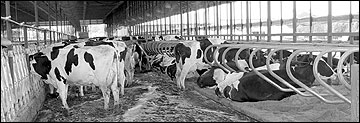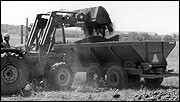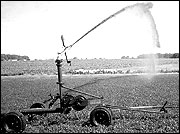Missouri dairy manure management can be classified into three systems — solid, slurry or lagoon — depending on the collection, transportation and distribution of manure on the fields. These systems are dependent on the amount of bedding and water dilution used by a specific operation. Many dairies use more than one system. For example, manure from dry cows and replacement heifers may be handled as a solid, whereas manure from free-stall barns, holding pens and milking parlors may be handled as a liquid, or solids may be separated from the liquid wastes so it can be used for other purposes.
Solid systems are commonly used in smaller operations (less than 100 cows) with bedded loafing barns or stanchion stalls. These systems minimize the volume of manure that is handled; however, a separate facility is required for liquid milking center manure.
Slurry systems maximize recovery of plant nutrients from manure and are often used where geologic conditions are unsuitable for a lagoon system. These systems increase the volume of manure to be handled because of the higher water content, but allow the manure to be handled as a fluid.
Many dairies favor lagoon systems because costs are lower than for other systems (Figure 1). Lagoons are applicable where flushing is desired and where a significant amount of lot runoff must be contained.
To minimize pollution potential and maximize nutrient recovery, incorporate livestock manure into the soil as soon as possible after application. To prevent applying an excess of plant nutrients (N, P and K), keep long-term records on the amount applied to each field. Make an analysis to determine the nutrient content of the manure and keep an estimate of the amount of manure applied. The amount of land required for manure disposal is usually based on 100 pounds of nitrogen used annually for plant production per acre.
Solid, slurry and lagoon systems, or a combination, can be developed to meet Missouri Clean Water Law requirements.
Consult local health and regulatory authorities and have all plans approved before constructing any manure handling system. A dairy operation with 700 or more cows is required by state law to obtain a permit from the Missouri Department of Natural Resources (MDNR). Any livestock manure management system, regardless of size, must be designed and operated in a manner that will not pollute surface or groundwater.
Contact your local Extension center or Natural Resources Conservation Service (NRCS) office for information about permits and assistance in developing manure management systems.

Figure 1
Dairy barns are built with a slope to facilitate flushing wastes to the lagoon.
Solid waste systems
Characteristics
Manure with a 75 to 80 percent moisture content can usually be handled as a solid. Manure at this moisture content has a consistency of peanut butter. Dairy manure, as excreted, contains about 88 percent water. So, to be handled as a solid, dairy manure must have the liquids drained off or bedding added. Twelve pounds of bedding per 100 pounds of fresh manure (about 4 pounds of dry straw per cow per day) is needed to permit handling dairy manure as a solid.
Scraping systems
Manure from bedded housing usually has to be handled as a solid. As a semisolid, manure can be scraped into a holding area where liquids are allowed to drain off. Scraping can be done mechanically by alley or by gutter scrapers pulled by cables or chains. In Missouri, small tractors with front- or rear-mounted blades are commonly used to scrape manure, and tractor scrapers function better in cold weather and tend to be more dependable than gutter scrapers.
Loaders
Front-end tractor loaders can remove manure from large areas with high clearances. Traction and stability can be a problem, however; wide front axles can improve stability and weights on the rear wheels or front-wheel-assist can improve traction. Skid steer loaders can work in cramped quarters and, in general, lessen time and hand labor expended.
Manure storage
Storage is required with most solid handling systems because of weather or limited available fields. A 60-day minimum storage capacity is recommended. The storage area should have all-weather access with surface runoff water diverted from the storage area. Any draining liquid should be directed to a soil-plant filter, lagoon or holding pond. A roof can eliminate the need for collecting and storing runoff from the storage area.
 Figure 2
Figure 2
Tractor with front loader moves solid manure to a spreader.
Manure spreaders
Most solid manure manure spreaders have moving aprons to move the load rearward to beaters. Flail-type spreaders have chains attached to a shaft that revolves at high speed to flail the manure out of the tank. These spreaders are also suited for semisolid manure (Figure 2).
Slurry waste systems
Characteristics
Manure with 90 to 96 percent moisture content can usually be handled as a fluid but may require special pumps. Manure at this moisture content has the consistency of a malt. Manure with 96 to 98 percent water content can be handled with ordinary pumps and flushing equipment if excessive straw or fibrous material is not present. For conventional pumping, two gallons of water must be added to dilute a gallon of fresh manure to 96 percent. Of course, this greatly increases the volume of manure to be stored and transported.
Flushing is not well suited to a slurry manure management system. The slurry system is designed to minimize dilution because it uses tank wagons for transportation and application. Therefore, hauling extra water with the manure is not profitable.
For example, assume a 1400-pound cow produces 14 gallons of undiluted manure per day. Hauling her yearly manure output will require 1.7 trips to the field with a 3,000-gallon tank wagon. If manure is diluted to 4 percent solids, 5.1 trips per cow per year will be required.
Slurry manure storage
Slurry can be stored in earthen basins, below-ground and above-ground concrete tanks and in lined and unlined metal tanks. Slurry storage areas are usually designed for a 120-day minimum storage capacity. In some locations, soil type can prohibit the use of earthen basins or require the use of a membrane-type liner. In these locations, concrete or steel manure storage tanks may be used.
Depending on the location of buildings and lots, it may be possible to gravity drain or scrape manure into the storage structure. In-ground tanks must be designed to resist lateral forces from the soil when the tank is empty. Outside drainage may be necessary to prevent the tank from floating when it is empty and the soil is saturated.
Most above-ground tanks have the added expense of a pump to transfer manure in and out of the facility.
Earth basins
Earth basins are usually partially below the original grade and partially above. The above-ground berms divert surface runoff water from the basin. Check with the NRCS and the Missouri Division of Geology and Land Survey for suitable sites, soil suitability and construction details to avoid seepage polluting surface water or groundwater. Earthen basins must be constructed with a clay seal (bottom and sides) to prevent leakage. In some cases, an artificial liner may be required. If soils have a high potential for collapsing, MDNR will not approve an earthen manure storage structure. In these cases, an alternate site must be selected, or a concrete or steel tank used for storage.
Scrape to storage
Scraping into below-ground storage areas can reduce equipment investment and maintenance costs. Any system that involves uncovered concrete lots, alleys or exercise areas increases the amount of runoff water that is hauled. Above-ground tanks require scraping into a collection pit and then pumping.
 Figure 3
Figure 3
Chopper-type slurry pumps are used for dairy manure.
Pumps
Pumps are frequently used to move manure into tanks and to move manure from tanks into tank wagons. High capacity (1,000 to 3,000 gpm) chopper pumps are used to move dairy manure from storage, with extra capacity to mix solids and liquids (Figure 3).
Tank wagons
Tractor-drawn tank wagons have capacities from 1,000 to 3,000 gallons. For long hauls and/or large operations, a tank truck may be more economical. Tank wagons can either spread the liquid on the soil or be equipped with knives to inject the manure into the soil. Injection reduces odors and nitrogen loss but requires considerable power to pull the tank wagon and injectors at a reasonable speed.
Injection can not be done when the soil is frozen or if it is too rocky. Likewise, spreading manure on frozen soil could pollute surface water if it rains or snows while the ground is still frozen.
Slurry manure systems require more land for application than lagoon systems because more nitrogen is retained.
Lagoon waste systems
Characteristics
Lagoon systems handle highly diluted manure (96 percent or more water) that can be pumped through irrigation systems. Most lagoon effluent is more than 99 percent water, so it has the consistency of water.
Flushing is the preferred method of manure collection and transportation for many Missouri dairies because it eliminates the labor required for scraping and moving manure to storage. Lagoons complement flushing systems because they provide storage at relatively low cost and usually do not cause unacceptable odor problems if judiciously located. Lagoons can also provide a source of flush water.
The anaerobic breakdown of manure usually results in acceptable odor levels when applied by an irrigation system.
Approximately 90 percent of the input nitrogen is lost or unavailable in an unagitated lagoon, but this can be an advantage if limited land is available for manure disposal. For large operations, lagoons provide the least-cost alternative on a per-cow basis. Consideration should be given to separating fibrous material (free-stall bedding, wasted hay, silage, etc.) from the manure flow going to the lagoon. Experience has shown that excessive amounts of this material can build up as surface crust and increase the rate of sludge accumulation in the lagoon, thus decreasing its long-term effectiveness as a manure storage and treatment facility.
Lagoons are usually designed for a 365-day storage capacity with all manure going into the lagoon. This includes dry cow manure, but not calf and replacement heifer manure. Also note that lagoons are not allowed by MDNR in areas where soil collapse potential is high.
Lagoons are usually formed by excavation and above-ground berms. The berms divert surface runoff water from the lagoon, but a diversion channel may be required. For a “DNR approved system,” a clay seal (compacted by a sheepsfoot roller) must be on the bottom and sides to meet NRCS specifications. Also, lagoons must be filled with fresh water to the minimum operating level and the berms seeded and mulched prior to operation.
Pumps
Conventional irrigation pumps are adequate for pumping lagoons if the intake is floated about 1 to 2 feet below the surface. The floating intake prevents surface debris interference and reduces the handling of sludge.
Centrifugal power-take-off irrigation pumps are a practical alternative for irrigating from lagoons. Small engine-mounted low-lift pumps can also provide adequate capacity and pressure to pump a small lagoon.
A complete manure management system includes a way of spreading manure in a pollution-free manner. It is important that all irrigation systems be monitored while effluent is being applied so no runoff occurs at the application site. The following are ways to spread manure:
Surface irrigation systems
Gated pipe can provide a low-cost distribution system for pumping small lagoons, especially where uniform application is not critical. Small systems can use a “homemade” gated pipe made from polyethylene pipe (e.g., using 2-inch diameter pipe for 50 gpm systems) with holes in the pipe at 30- to 40-inch intervals. The holes must be small enough that flow is distributed out of all of the holes, but large enough that they don't become clogged by small solids. These systems are feasible for small lagoons handling only milkhouse manure but have been used for larger lagoons. For larger systems, commercial gated pipe with adjustable gates is an alternative.
Sprinkler irrigation systems
For irregular rolling land, use a sprinkler irrigation system instead of gated pipe. Various sprinkler systems are suitable; the choice depends on the desire to save labor or money.
Stationary hand-carried systems
For small operations, one or more small sprinklers fed by 3- to 6-inch portable pipe is adequate if time and labor are available. For even smaller operations, a 1 DA 2- to 1-inch nozzle sprinkler(s), covering 1 DA 2 to 2 acres per set, can be used. For larger operations, a high volume gun sprinkler with a 1- to 2-inch nozzle, covering 2 1 DA 2 to 6 acres per set, can be used to reduce labor requirement.
 Figure 4
Figure 4
Traveling guns are an ideal means of irrigating lagoon effluent onto fields.
Moving sprinkler systems
To reduce labor and to accommodate larger operations, a traveling gun (Figure 4) or a center-pivot irrigator may be more cost-effective than hand-moved sprinklers. Different models of the small traveling guns are now available. Larger traveling guns, used for crop irrigation, can be used if crops are irrigated conventionally or if rental units are available.
References
- USDA-Natural Resources Conservation Service. 1992. Agricultural Waste Management Field handbook, Part 651. USDA-NRCS, Washington, D.C.